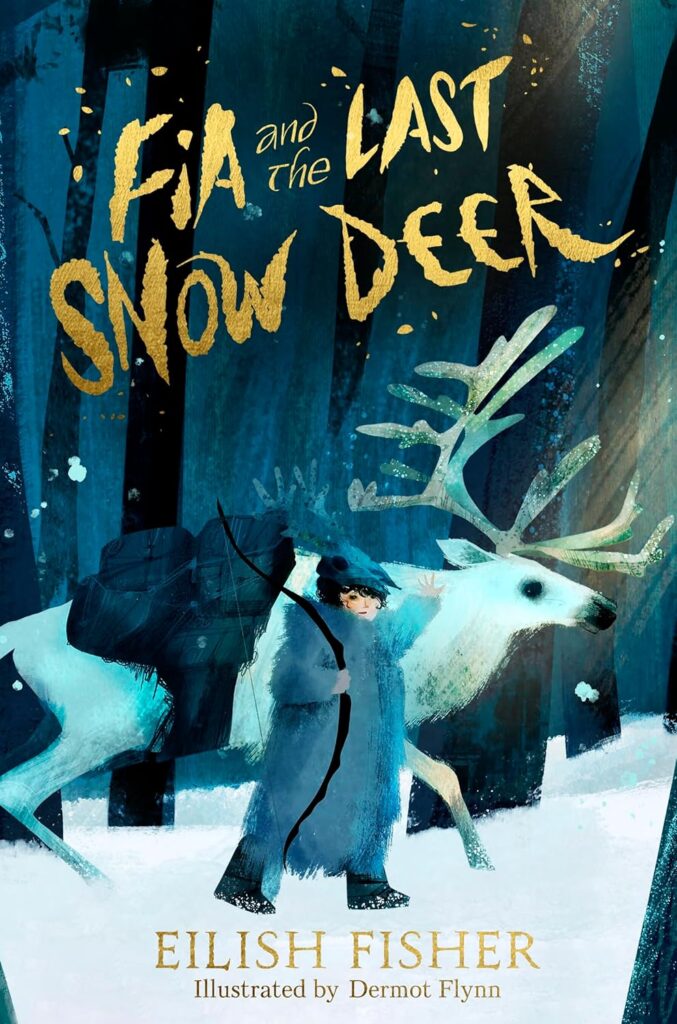Written by Eilish Fisher, illustrated by Dermot Flynn (pub. Puffin Books, 2024)
Suddenly I know what I have to do
to keep Solas safe.
The prophecy says the sacrifice must be given
freely,
gladly,
with hope.
Nothing about
blood sadness despair.
It’s been three years since the snows came, since the plants started to wither, and the herds moved on. The prophecy says that the Deer Mother will one day wake the sun, and they shall return to the world bringing warmth and life with them. But without food and warmth, will Fia’s village survive until then?
There’s a part of the prophecy that Fia has never heard though – that there will come a time when the sun won’t return. When that happens, the Deer Mother will need a sacrifice of the final doe by the time of the Solstice.
Fia and Solas the snow deer have grown up together, born under the same Solstice moon thirteen years ago. Solas has so far been spared due to the prophecy, but things are desperate. To save Solas from being sacrificed, Fia knows what they must do – they must find the Deer Mother themselves.

Fia and the Last Snow Deer is set in Ancient Ireland, in a world where nature and magic are closely entwined. It’s a land of ethereal beings and nameless monsters, but also of ordinary folk simply trying to survive – as the best mythological tales are.
Because that’s what this is. Yes, the details themselves may be from the Fisher’s imagination, but the setting, the vibe, the story feels deeply rooted in mythology. From the anthropological explanations for how the world works, to a prophecy that begins the hero’s supernatural journey, this tale would feel perfectly at home amongst long-standing examples of Celtic mythology.
(I could go on for a while about how Fia’s journey feels like a “voyage to the Otherworld”, however I’ll keep my focus on the actual book instead!)
The prophecy states that the Deer Mother needs a sacrifice but, like all good prophecies, this can be interpreted in different ways. This is why Gerd – the village shaman, and Fia’s great-grandmother – sends her and Solas on their quest.
With them comes Mish, Fia’s cousin. There is tension between the two at first due to Mish being chosen to join the hunters over Fia, despite her being the superior hunter. But everything happens for a reason, and this is no exception.
Fia is headstrong and incredibly talented, but lacks maturity and real-world experience. Mish balances this out well by using his knowledge of the world to keep them going, but in return he needs Fia’s open-mindedness. It takes time, but each comes to appreciate the other for what they bring to the difficult journey, and to their friendship.
Along the way, they meet a wolf, and it is here that we first get the suggestion that Fia is more special than we realised. Gerd’s stag-skull headdress, which she gives to Fia before she leaves, gives her the ability to connect with the wolf in a way that it does not when Mish wears it. But what does it mean? And where did the wolf come from?
The story is divided into sections that cover each day counting down to the Solstice, which gives the reader the constant reminder that they’re up against the clock. It may sound like a minor thing, but I appreciated the realistic amount of progress that they make each day, rather than feeling like too much is being crammed into a short amount of time.
If you think that a journey through a snowy expanse of landscape would be boring, you couldn’t be more wrong. It’s a real testament to Fisher’s writing that she can describe the world so evocatively that you can almost feel the chill in the air, and hear the whispers of the Shadows amongst the trees.
Even the calmer periods feel a bit tense, not knowing what they may be walking into next, but also with a warmth as we watch the two youngsters learn, struggle, and grow together. And the tense periods…well, let’s just say it’s not an easy journey, and it’s not just the geography and weather that’s hostile.
This is all helped along by Flynn’s stunning illustrations. I defy you to not be immediately enchanted by the cover with its flecks of gold, showing Fia and Solas, and Mish and Wolf on the reverse, looking altogether like Flynn has just snapped a shot of them as they make their way through the trees. (We’d also recommend slipping the dust jacket of the hardback off to see the beautiful image underneath!)
The text is laid out in verse, with short lines that sometimes drop down partway through sentences. Not only does this give it a classical feel, but this works perfectly with the frequent use of double-page illustrations, where one side often features text in the negative spaces. The words and the images are inextricably intertwined, and both are all the better for it.
Although the characters make a physical journey, this book is so much more than that. It’s an emotional and a spiritual journey too, about trust and growth, about adversity, belief and sacrifice – whatever they may look like. It’s amazing to think that this is Fisher’s debut, and we look forward to seeing where she takes us next.
If you want to visit the Deer Mother with Fia and Solas, you can grab a copy of Fia and the Last Snow Deer at the link below.
(Disclosure: If you buy books linked to our site, we may earn a commission from Bookshop.org, whose fees support independent bookshops.)
Looking for more folkloric reads? Check out some of our previous book reviews here.

